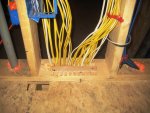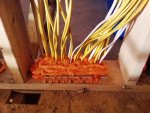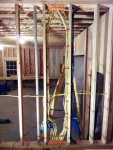liquidtite
Senior Member
- Location
- Ny
gotcha
I dont get why deration is needed.In the code when they discuss drating isnt it ccc in conduit?Also you dont have to drate ccc when they are runing through a nipple witch is usualy longer than the lenth of the 2x4.So if you had two panels nippled together and instead of using thhn you used nm would you have to drate.
Only time you would have problems with cables going through the same opening in the framing member is if you bundled 10 or more current carrying conductors into the same conduit, cable assembly or in close proximity to one another because the derating factor would be at least 50% and could be higher if you had to double-derate for ambient temperatures as well.
Type NM-B cable, NEC Section 334.80
Type NM-B cable is required to be derated when more than two cables are installed bundled together. NEC Section 334.80 specifically states that Type NM-B cable’s ampacity shall be derated when more than two NM-B cables are installed in thermal insulation without maintained spacing between the cables. This change was based on CDA studies of NM-B cable installed in walls with various thermal insulations. The study showed that without spacing the conductors, temperatures exceeded the maximum operating temperature of NM-B cable. This requirement is in addition to the 2005 NEC requirement for the derating of more than two cables installed through a draft stopped hole.
Report on Proposals ? May 2004
NFPA 70
7-150a Log #CP700 NEC-P07
(334-80)
Final Action: Accept
Submitter: Code-Making Panel 7
Recommendation:
Add a new paragraph to 334.80 to read as follows:
"334.80 Where more than two NM cables containing two or more current-carrying conductors are bundled together and pass through
wood framing which is to be fire- or draft-stopped using thermal insulation or sealing foam, the allowable ampacity of each conductor
shall be adjusted in accordance with Table 310.15(B)(2)(a)."
Substantiation:
Code-Making Panel 6 Rejected Proposal 6-31 to add the proposed text to 310.15(B)(2)(a) and provided the following Panel statement:
"The Panel agrees with the intent of the Proposal, however, this material is more appropriately addressed in 334.80 since the Proposal
only applies to one type of cable, and Code-Making Panel 6 covers all wiring methods. Therefore, Code-Making Panel 6 has forwarded
this Proposal to Code-Making Panel 7 for action."
The substantiation provided by the submitter, Travis Lindsey, of Proposal 6-31 was:
"Recent experimentation shows the possibility of dangerous conditions when loaded circuits are brought into close proximity to each
other inside a fire- or draft-stop, where the ability to dissipate heat is extremely limited. Cable temperatures well in excess of their 90?C
rating were encountered, with no overcurrent protection present for these conditions. Results indicate that immediate adjustments
should be made to the NEC to apply at least to the specific case represented by the experiment. Such a proposal is being made, with a
supplemental report offered as technical support."
Panel Meeting Action: Accept
Number Eligible to Vote: 15
Affirmative: 15
you may want to take a look at this..
Chances are your install runs cooler than the one in Nevada. I did not read through that very thouroughly and don't know all the details. Remember the insulation not only will keep external heat out it will also keep internal heat in. That was why I said I didn't think it would have a major impact on things. Actual loading conditions of the cables are what will make the bigger difference in internal temperature not the ambient temperature outside the wall. Cooler exterior ambient mostly just means it will take longer to warm it up. I have never been to Maine, but I'm sure it does get moderately warm or even down right hot at times in the summer months.This test was done in Nevada on an outside 2x4 wall with R11 insulation. This is VERY different than my house in Maine in an inside (butting the garage) 2x6 wall with R21 insulation. And for those who say it didn't, the test DID show that outside temperature effects the heating of conductors. I suggest you guys re-read that document. My bigger cavity (2x6), thicker wall insulation (R21), and being an inside wall in lower outside temperatures in Maine should all decrease the chance of over heating, right ??? Realistically I don't think i have an issue. But I understand the code and the point and obviously wont do this again.
Taking the wires out of the panel would be a nightmare trying to remember exactly where each one went (neutrals, grounds, what knockout and breaker....). You know i'll end up short on a few wires (long a others) and would have to junction in or above the panel. Talk about a mess and pain in the ass. I'm hoping the code enforcement officer will let me cut out the plate and piece one (will multiple holes) back in its place so I don't have to touch the panel. Well i'm actually hoping he lets its it go. But it doesn't sound very good from what you guys are telling me
Chances are your install runs cooler than the one in Nevada. I did not read through that very thouroughly and don't know all the details. Remember the insulation not only will keep external heat out it will also keep internal heat in. That was why I said I didn't think it would have a major impact on things. Actual loading conditions of the cables are what will make the bigger difference in internal temperature not the ambient temperature outside the wall. Cooler exterior ambient mostly just means it will take longer to warm it up. I have never been to Maine, but I'm sure it does get moderately warm or even down right hot at times in the summer months.
I do agree, the loading conditions will make the bigger difference in heating vs the outside temperature. The Nevada test showed that at 87F outside, (with the 2x4 walls and R11 insulation) in combination with 73% loading, the bundle temperatures could reach excess of 194F. I understand the point but realistically here in Maine with my house conditions and loading conditions, I will never face a heating problem within the firestop foam. I guess this is why some enforce it and some don't. But code is code i guess.
Most of your general purpose circuits will not create very much heat, as they typically only have a small load on them, or if a larger load it is usually limited to short run times. Anything that is continuously loaded will be a difference maker.
Heating and air conditioning are most common things in a dwelling where you will notice heating of conductors. Most other loads are intermittent enough in nature that you seldom notice any any heating unless there is a problem with a connection or something like that, but it is there when conductors are loaded.
Go to an industrial place where many loads are continuous and you will notice there is heat inside panels, gutters, junction boxes, etc. Most of this heat is coming from within the conductors in panelboards there is some contribution from overcurrent devices.
Conductors do have resistance and where you have current flowing through a resistance you will have heat.
If it were my house I wouldn't care about those fire-stopped holes. The testing was done using heavily loaded cables. The real world application in a house will almost never duplicate the test.



If a 14/3 or 12/3 wire is used than it counts as 3 conductors. So, depending on what is used, you can place 3 or 4 wires per fire stopped hole.
Specifically for an MWBC, containing L1 and L2 and N (and a common trip or handle tied breaker), 12/3 or 14/3 would only count as two current carrying conductors. But I doubt that your inspector could deal with that either.
334.80 Ampacity. The ampacity of Types NM, NMC, and NMS cable shall be determined in accordance with 310.15. The allowable ampacity shall not exceed that of a 60?C (140?F) rated conductor. The 90?C (194?F) rating shall be permitted to be used for ampacity adjustment and correction calculations, provided the final derated ampacity does not exceed that of a 60?C (140?F) rated conductor. The ampacity of Types NM, NMC, and NMS cable installed in cable tray shall be determined in accordance with 392.80(A). Where more than two NM cables containing two or more current-carrying conductors are installed, without maintaining spacing between the cables, through the same opening in wood framing that is to be sealed with thermal insulation, caulk, or sealing foam, the allowable ampacity of each conductor shall be adjusted in accordance with Table 310.15(B)(3)(a) and the provisions of 310.15(A)(2), Exception, shall not apply. Where more than two NM cables containing two or more current-carrying conductors are installed in contact with thermal insulation without maintaining spacing between cables, the allowable ampacity of each conductor shall be adjusted in accordance with Table 310.15(B)(3)(a).
So basically if you have more than 2 wires in a fire stopped hole than you have to derate in accordance with Table 310.15(B)(3)(a). If you do the math in that table you will find that 14/2 is still good for 15 amps and 12/2 is still good for 20 amps until you bundle more than 9 current carrying conductors together. Each 14/2 or 12/2 wire has 2 conductors. If a 14/3 or 12/3 wire is used than it counts as 3 conductors. So, depending on what is used, you can place 3 or 4 wires per fire stopped hole.
Thanks for all the help and input. This is a great forum. I'm sure i'll be back.
You're reading the requirement incorrectly, it says for more than two cables. And you only count the CCC's not every conductor. A 3 wire cable in this application will almost always only count as 2 CCC's.
Or perhaps more commonplace still, a neutral/hot/switched to a split outlet.Might want to lower that percentage a little ... or even switch loop with a common and two switched return conductors
Or perhaps more commonplace still, a neutral/hot/switched to a split outlet.
I dont get why deration is needed.In the code when they discuss drating isnt it ccc in conduit?Also you dont have to drate ccc when they are runing through a nipple witch is usualy longer than the lenth of the 2x4.So if you had two panels nippled together and instead of using thhn you used nm would you have to drate.
Also applies to conductors and cables that are bundled together for more than 24 inches.I dont get why deration is needed.In the code when they discuss drating isnt it ccc in conduit?
Correct, nipple length can be up to 24 inches without derating. Same with NM or any other cable. The change is with NM cable and bundles that pass through a hole that is sealed by some manner for firestopping, air infiltration, etc. There is no mention of length, so it applies to any hole that gets sealed up. Pass same cables through a hole that does not get sealed up and you are back to the 24 inch nipple rule that has been around for a long time.Also you dont have to drate ccc when they are runing through a nipple witch is usualy longer than the lenth of the 2x4.So if you had two panels nippled together and instead of using thhn you used nm would you have to drate.
